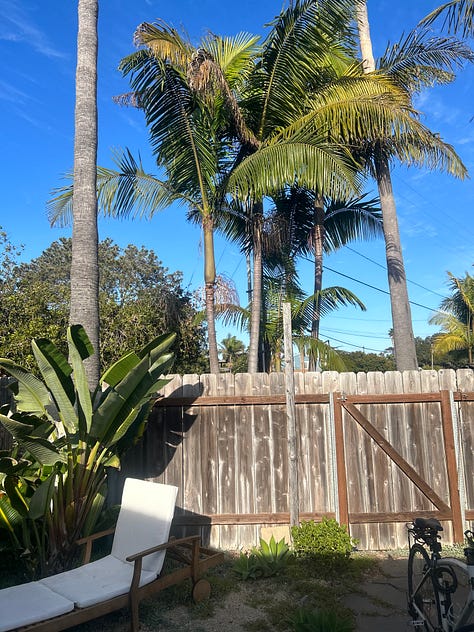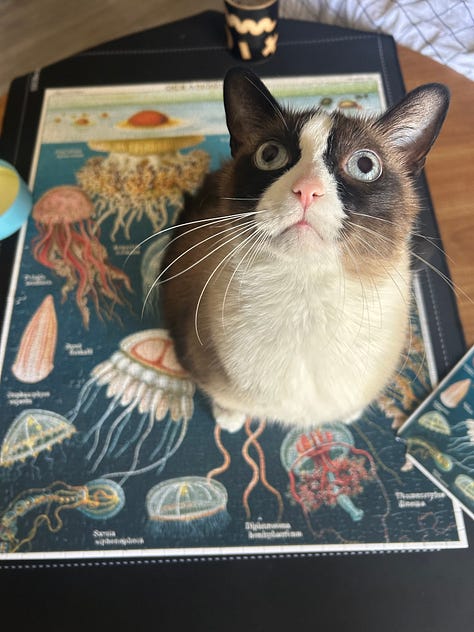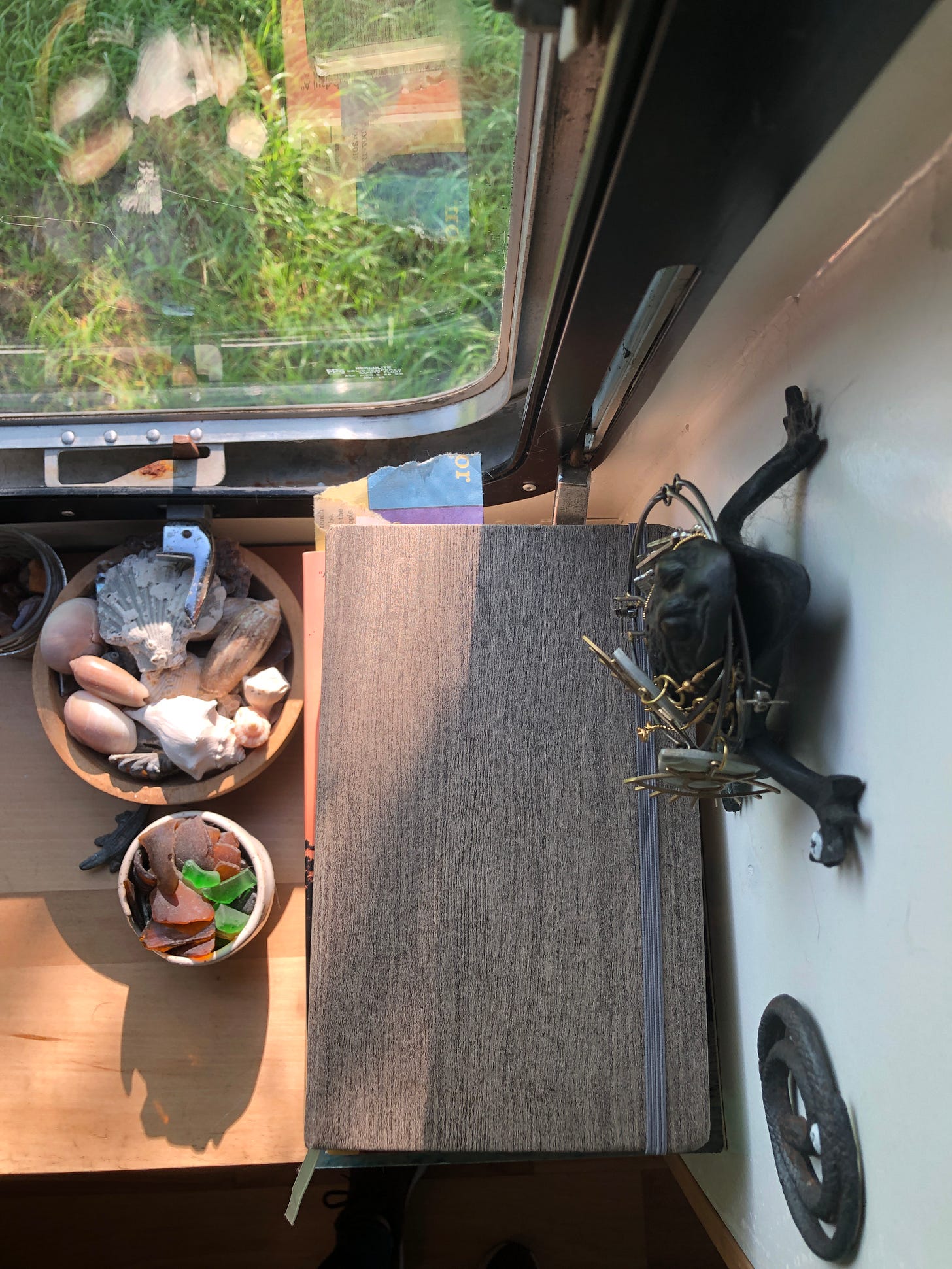On the other side of Airstream Living
nearly 6 years in & almost 7 months out of tiny home life
Welcome to Following Studies, an adventure through subcultures and obsessions. If you haven’t subscribed, be sure to follow along for the fun.
We’d always said we would move out of the Airstream when it didn’t make sense anymore. That snuck up. The Airstream was small, after all, but it had always been small.
Before we moved in, we’d spent most of the weekends for two years renovating this little tin. We pulled out old cabinetry, pipes, decaying bones, and squirrel poop from the walls and patched the soft subfloor. For breaks in the day, we went to a small grocery store, brought back blocks of cheese, crackers, beer, and wine, and sat to look at everything we’d done and had to do. Friends would sometimes come by and sand a bit. My Dad spent several weekends with us, putting pipe together and ripping old Airstream parts out so we could one day put in new ones. For the longest time, it seemed like we were making no progress - the days pulling out old rivets didn’t visually amount to much. Inside the airstream, I would sit on the subfloor and stare up at the curved aluminum walls. The seams made it look more like sitting in the belly of a whale than what would one day be home. And then, after the long slog of putting installation back, rewiring the Airstream, setting out new pipes, and all the other boring, laborious things that make up a renovation, we were ready to build the cabinetry and the bathroom. At that moment, I blinked, and we moved in. All the while, an undercurrent existed. The Airstream would quite literally carry us into what was next.
Sometimes Marc, my husband, will talk about the time we cooked on a hot plate before we installed the stove or how when we moved in, the cabinet faces weren’t up, and the drawers weren’t made, so all of our clothes and dishes and towels and books stared at us. I remember reconfiguring where we would put our things, deciding that a drawer would be a hamper, and having a small washer in the Airstream we bought off Craigslist for $70 that shook the whole house and made me car sick. I remember sitting at the little kitchen table that we would eventually rip out to build a larger desk and curling up on the couch cushion that started as yellow until we dyed it burgundy and later had a new cover stitched up that was rust.
The idea of moving out of the Airstream crept up on us, and suddenly, it was the biggest thing in our small house. We had outgrown it. It had taken almost six years to do that. We lived stationary in North Carolina in our Airstream and then began to travel. Then, we lived in Georgia, Louisiana, Texas, Indiana, and California. We’d driven across the country and made a lightning bolt on the map. We replaced a tire on one haul of our trip and patched another.
We parked in a driveway on a mountain and slept in Cracker Barrel parking lots, Walmart parking lots, and truck stops. Most places we went, we stayed longer than we thought we were going to. A planned week in Texas turned into almost four months. We sat in a restaurant and watched the news the day we arrived in Texas. They were canceling SXSW. COVID-19 was everywhere. We watched the bluebonnets bud, then bloom and die, and we split for Indiana before the Texas summer heat began to scorch. We spent a summer parked in a friend’s driveway and I biked almost daily through the greenway built on an old railroad line covered with trees.
Then we moved to California. A first stop in Missouri, a long drive through Kansas, a quick stop in Colorado, a night in Utah, a pit stop at a hot spring in Nevada, and we were there. The days after we moved to California, the sky turned orange with smoke, and under the redwoods, everything looked prehistoric. I stared through the sepia tone, and Marc signed onto his graduate architecture classes. Those months, we would drive the coast, stop at tidepools, and marvel at our new state.

It was COVID-19 still and we felt incredibly far away. That year, we had our first Christmas as a married couple away from North Carolina. By then, we were in the San Bernardino Mountains in Southern California and only two hours away from Los Angeles, but we got so much snow we’d climb on the top of the Airstream to push it off and then cannonball into it.
Even though we had quite literally lived all across the country, I hadn’t considered us part of the #vanlife or nomadic community until recently when I was trying to remember what address was attached to an old retirement account. I sat on the phone with a customer service specialist who listened to me list off 14 addresses to verify my identity. I kept apologizing, but she stayed on the line, and we both started laughing when I finally named the right address. It was a place we hadn’t lived in years when I was still job coaching and before Marc had decided to go back to school. It was the place we first lived in the Airstream.
We had moved a ton in the Airstream. It was fun and fresh, and for two people who didn’t really know where they wanted to settle, it felt like the ultimate solution: a home that was ours that could go wherever we wanted to.
The last place we lived in the Airstream was a town where Marc was going to school in the Inland Empire. He finished school. I was done with haphazard agreements with landlords so we could avoid living in an RV park by renting a driveway or part of a yard. I came home one day, looked around, and knew I was completely done living in the Airstream. That this season of our lives was closing and that, for us, the Airstream didn’t make sense anymore.
It can be hard to leave a life phase that’s become so ingrained in your identity and to unravel yourself from a thing that’s been such a large part of your life. But I’ve left churches, doctrines, and relationships. I’ve left schools, jobs, and towns that weren’t what they should be and when I wasn’t what I should be in them.
For almost six years, our home had wheels, which felt light and giving and full of adventure. Eventually, those wheels didn’t feel light and filled with potential. They felt heavy and constraining, compacting us in. And while sometimes, the growth is to stay in something, to sort it out, other times, it’s to look around and walk into whatever is next.



Some friends visited our new apartment a few weeks after we moved in and said it looked like we had lived there for a year — you settled in quickly, they said. We did, but we were ready. When we moved into the apartment, I ordered the Dusen Dusen tissue box I’d coveted forever, and we got a king-size bed. I stocked the freezer, got a Costco card, and walked the aisles looking at bulk-sized toilet paper and chicken wontons in the freezer section and $4.99 rotisserie chickens. Marc built shelves and landscaped the yard. We didn’t have a tiny house anymore. We had a one-bedroom apartment and a yard. There was room for more books and hobbies. I bought puzzles to spread on the counter, and we’d pull the sofa out to watch movies together. We could now have more than a week’s worth of vegetables shoved Tetris-style in a mini fridge and we could also have space to dream up what was next. And suddenly, that gave us what the Airstream used to - that expansive feeling of possibility.
Recommended Reading
Nomadland: Surviving America in the Twenty-First Century - I’d be remiss to talk about living in an Airstream without mentioning Nomadland by Jessica Bruder, which shares the reality for many older Americans who began to live nomadically after the recession. Living in a travel trailer has always been a polarizing subject, and it’s one of those things, like so many things, that is considered cool if you are middle class and bad if you are living in poverty. It’s one thing to choose to live in a travel trailer, and it’s another not to have a choice.
The Modern Caravan: Stories of Love, Beauty, and Adventure on the Open Road - Written by my dear friend
, you’ll find Marc and I in this book, as well as other tiny dwellers who have renovated their travel trailers.I’ve written about living in our Airstream before. You can read about it here and here.
I’d love to hear what you’ve left behind and brought with you into new life phases - or if you have a particular wild travel story.







I feel this deep in my bones. I'm transitioning out of my current tiny house (my camper!) into a larger tiny house (a dome!), and everything suddenly feels...not right. The current house, which I adore deeply, feels too cramped, too dingy, too inhospitable. Literally nothing has changed other than my viewpoint and anticipation of having a bit more breathing room.
What a beautiful, beautiful reflection